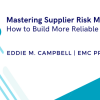Not many people can say they haven't heard the voice of a young child asking “Why?” No matter what the subject matter we all seem to be programmed to want to know the “why” behind the “what.” The procurement workplace is no different but we tend to find difficulty in connecting these. Understanding the ins and outs of theory and practice become essential to success in the procurement world.
So, how do we take theory and put it into practice? Albert Einstein is quoted, “In theory, theory and practice are the same. In practice, they are not.” Project managers or leaders of transformation understand that starting with a theory is a sound business principle and really the bare minimum in the process. But, very successful project managers can transition that theory into practice and lead their team to greater outcomes rather than settle for the status quo.
Over the past four years, our team has led the company through two major procurement and supply chain transformations. As you well know, this is no small feat, when you consider all the other enterprise transformations taking place at the same time within healthcare. All that being said, we have learned a lot traveling the bumpy road: taking theory and putting it into practice.
Several key themes have been a key to our success.
FIT OVER FUNCTION
Having spent the better part of 25 years in the procurement and supply chain industry, I have witnessed many different models and wireframes of processes. Most have commonalities, but all tend to differentiate themselves in certain areas. I am reminded of my time as a consultant, when a follow-up meeting with a client was completely focused on modifying our standard sourcing process in an effort to compensate for shortfalls in a prior project. The big take away from that meeting was that we must be flexible to meet the needs of the client.
Last year, our team took on the challenge of redefining segmentation, supplier risk and procurement and supplier management. Immediately I pulled a book off the shelf: Strategic Sourcing in the New Economy written by Keith, Vitasek, Manrodt and Kling became the backbone of taking theory and putting it into practice. We had circulated some of the provocative ideas in this book around Sourcing Business Models (SBM) and had gained traction to utilize the theory. We also knew that the theory presented in the book did not entirely match our business needs and requirements. As a regulated industry within healthcare, there are several risk and compliance areas that Sourcing Business Models touched upon but never contemplated the uniqueness of our company. I went to directly to the source to find out what our next steps could look like. Without any sense of ownership, Kate Vitasek’s first comment was, “Break SBM down and build it up for your needs, fit is the most crucial factor.” Thanks to that guidance, an augmented Sourcing Business Model became the keystone for our program. We were able to effectively use the base components of SBM and meet the needs of many internal and external stakeholders.
FIND BROADER PURPOSE
Every year, we take a survey of the associates at our company and find two themes that filter to the surface: how do we fit into the broader company and a desire to understand "why" decisions are made. Why do we spend time on a procurement transformation? Why do we process a contract in this manner? It is imperative for us to connect the dots for our team. This is especially true when it comes to implementing a new theory. Our team must understand the theory, understand the reasoning and eventually take ownership and accountability for the practice. If we are truly going to change processes and shift mindsets, we need to go into the enterprise as a single voice. That voice is the loudest when a broader purpose is fueling it.
FORMULATE AGILITY
Over the past few years, our company has migrated to an Agile implementation company. We see the benefit of prototyping, rapid release and the flexibility that this methodology brings to the table. It is not lost upon the Procurement team that Agile applies to process improvements as well. In the past, you could see frustrations within the team mount as we communicated change to executives and stakeholders. As each person became involved, we were exposed to unique perspectives and important questions to drive our strategy and theory. When we completed our “communication roadshows,” we were faced with a process improvement that was very different than the one we had started out with. There is an amazing amount of great advice out there concerning change management, but as we put theory into practice, the ability to be agile came to the top. We wanted to show quick wins, bring data to life and most importantly meet the needs of our stakeholders. In the end, the procurement team would laugh at the number of modifications made, instead of voicing frustration because they understood how our agility had led to a better product than we could have developed on our own.
These three focus areas helped guide our success with Sourcing Business Models. More importantly, they became guardrails within the procurement team for any improvement moving forward. From a straightforward process improvement platform to more rigorous change, putting theory into practice is still not easy. But it is achievable when the practice fits, the team is aligned, and the key players involved are willing and able to be nimble in their approach. So in the end remind yourself that it’s worth the time and effort to prove Einstein wrong...what does he know about procurement anyway?









